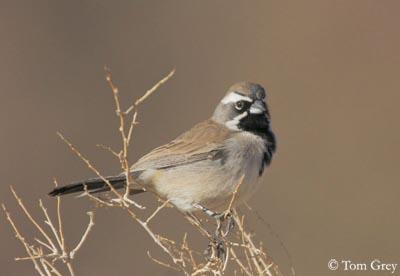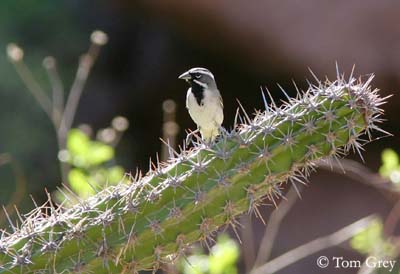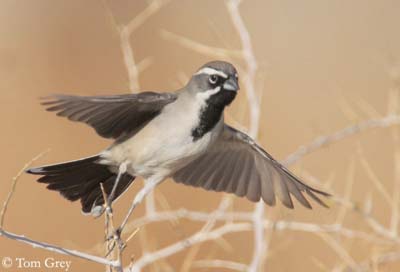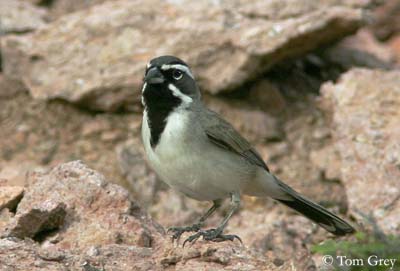
Black-throated Sparrow
Amphispiza bilineata
Passeriforme Order – Passerellidae Family
BIOMETRICS:
Length: 12 à 14 cm
Wingspan: 22 cm
Weight: 11 à 15 g
LONGEVITY: Up to 6 years
DESCRIPTION:
Back-throated Sparrow has grey brown upperparts. Underparts are white, with black bib. Tail is long with rounded tips and white edges.
Head has dark grey crown, tapering to a point on forehead, and contrasting with conspicuous white eyebrows and white malar stripe. Cheeks are dark grey.
Blackish bill is cone-shaped. Eyes are black with half white eye-ring below. Legs and feet are blackish.
Both sexes are similar.
Juvenile lacks black bib. It has streaked upper breast and bold white eyebrows. Back is finely streaked.

VOICE: SOUNDS BY XENO-CANTO
Black-throated Sparrow utters a rapid high-pitched song: two clear notes followed by a buzz or trill, sometimes several. The first two notes are quick and distinct; the last one is a prolonged silvery trill.
HABITAT:
Black-throated Sparrow inhabits drier and hotter desert valleys, where there is sparse vegetation, and bush and scrub environment.

RANGE:
Black-throated Sparrow breeds from the Great Basin, through south-western United States, into northern Mexico. It may be summer resident in the Basin.
It winters in southern United States deserts and in Mexico.
BEHAVIOUR:
Black-throated Sparrow runs around on the ground, searching for insects which allow them to get moisture from its food, but if water is present, it will take advantage of it. Black-throated Sparrow reduces its activities when under water stress, that reduces their pulmonary water losses.
It also may ingest some gravel to aid in digestion. It forages on the ground, running with cocked upward tail.
It is partly migratory, and except during breeding season, it normally lives in flocks. In winter, they feed in loose flocks.
Male sings to defend its territory. This species form monogamous pairs and male also sings to attract the female.

FLIGHT:
Black-throated Sparrow performs short flights with rapid wing beats.
REPRODUCTION:
Breeding season may vary, according to rain fall and food resources.
Nest is situated on or near the ground, in a low shrub where it is hidden. Nest is cup-shaped, loosely built with small twigs and plant fibres, and lined with fine and soft materials, such as grass, plant down and rabbit fur.
Female lays 3 to 4 white or pale blue eggs. Incubation lasts about 12 to 15 days, by female. Both adults take care for the chicks, feed them, and female broods them. Young fledge at about 10 to 11 days of age.
This species produces two clutches per year.

DIET:
Black-throated Sparrow feeds mainly on insects and seeds, according to the season. It will also consume green buds and fresh leaves, but also fruit and berries. It can survive long period without water, getting water from its food.

PROTECTION / THREATS / STATUS:
Black-throated Sparrow is declining with increasing development and habitat loos. They don’t adapt to suburbs.
However, populations are still widespread in appropriate habitat.
Fr: Bruant à gorge noire
All : Schwarzkehlammer
Esp : Chiero de Garganta Negra
Ital : Passero pettonero
Nd : Zwartkeelgors
Sd : Svartstrupig sparv
Photographs by Tom Grey
His website: Tom Grey's Bird Pictures
Text by Nicole Bouglouan
Sources :
FIELD GUIDE TO THE BIRDS OF NORTH AMERICA by National Geographic Society - National Geographic Society - ISBN: 0792274512
A GUIDE TO THE BIRDS OF MEXICO AND NORTHERN CENTRAL AMERICA by Steve N. G. Howell, Sophie Webb - Oxford University Press - ISBN: 0198540124
BIRDS OF THE GREAT BASIN – by Fred A. Ryser - Univ of Nevada Pr -ISBN: 0874170796
All About Birds (Cornell Lab of Ornithology)
Animal Diversity Web (University of Michigan Museum of Zoology)
Bird Web (Seattle Audubon Society)
What Bird-The ultimate Bird Guide (Mitchell Waite)